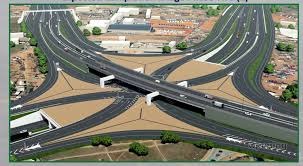The Tema Motorway Interchange is more than a simple infrastructure project. It is a story of transformation.
It connects the aspirations of the past with the realities of the present and the hopes for the future. From Kwame Nkrumah’s vision of modern infrastructure in the 1960s to the current government’s commitment to addressing 21st-century challenges, the interchange embodies continuity and progress.
At its core, the interchange unites people, businesses, and communities, fostering economic growth and improving lives. Once complete, it will not only ease traffic congestion but also serve as a reminder of what can be achieved through determination and collaboration.
Ghana’s journey forward like the motorway itself may encounter challenges, but it is always moving ahead toward a better future.
The Tema Motorway Interchange is a beacon of progress, propelling Ghana into a new era of connectivity, opportunity, and hope. The Tema Motorway Interchange stands as a testament to progress and connectivity at the heart of Ghana. As a vital link between Accra, the nation’s capital, and Tema, the country’s industrial hub, its history is intertwined with Ghana’s aspirations for economic growth.
However, as Ghana’s population and economy grew over the years, the motorway became overwhelmed by traffic, limiting the movement of goods and people. What was once an effective road network turned into a frustrating bottleneck, hampering productivity and causing delays.
With the dawn of the 21st century, the necessity for an upgrade became evident, leading the government to embark on a transformative project—one aimed not only at easing traffic but also at reflecting Ghana’s increasing prominence as a West African economic powerhouse.
Phases of the Project: Building the Future
The motorway upgrade was split into two phases.
Phase One of the project commenced in 2018 and concluded in 2020. This phase saw the construction of a two-tier interchange, which significantly eased traffic flow and reduced travel time. Despite these improvements, the rapid population growth and surge in vehicle numbers soon revealed the need for further expansion.
Now, Phase Two is underway. This phase focuses on the construction of a third-tier flyover to further alleviate congestion and enhance the connection between Accra and Tema. The expansion includes a 1.2-kilometer flyover, four ramps connecting the new tier to the existing interchange, improved drainage and lighting systems, and upgraded infrastructure for both pedestrians and cyclists.
Voices of the People: Hopes, Frustrations, and Anticipation
Ben, a stationmaster at the Tema roundabout station, expresses his excitement for the interchange’s completion. “Once traffic flows smoothly, our bus drivers will be able to complete more trips in a day, which means more income for all of us,” he shares with enthusiasm.
Erica, a commuter who travels daily from Tema to her workplace in Accra, recounts the challenges she faces. “I’ve had to leave home as early as 5 a.m. just to avoid being late for work. I can’t wait for the new interchange to be ready,” she explains, highlighting the human impact of the delays caused by traffic congestion.
A local trader, Ekua, who depends on the motorway to transport her goods, reflects on how the traffic jams have affected her business. “I’ve lost customers because I can’t get my goods delivered on time. Hopefully, once this project is done, things will improve,” she says, expressing hope for the future.
The Community, a collective voice of commuters, traders, and residents speak with mixed emotions. While many are frustrated by the ongoing construction delays, there is a shared sense of optimism that the project will lead to better days ahead.
Past, Present, and Future: A Symbol of National Progress
The Tema Motorway has long symbolized Ghana’s post-independence dreams. As a critical artery linking Accra to the industrial port city of Tema, it initially fueled economic growth by facilitating the movement of goods and people.
However, as the decades passed, the once-proud motorway struggled to keep up with the demands of a growing nation, transforming into a source of daily frustration for thousands of Ghanaians.
The ongoing construction of the new interchange reflects the delicate balancing act between modernization and disruption. Traffic diversions, construction noise, and occasional delays have tested the patience of residents and commuters. Yet, the promise of a modern, efficient road network continues to inspire hope.
When completed, the new Tema Motorway Interchange will not only enhance traffic flow but also serve as a model for infrastructural development across Africa. More than just an engineering feat, it will be a symbol of Ghana’s resilience, growth, and forward-looking ambition.
By: Elsie Nana Adjoa Aidoo













